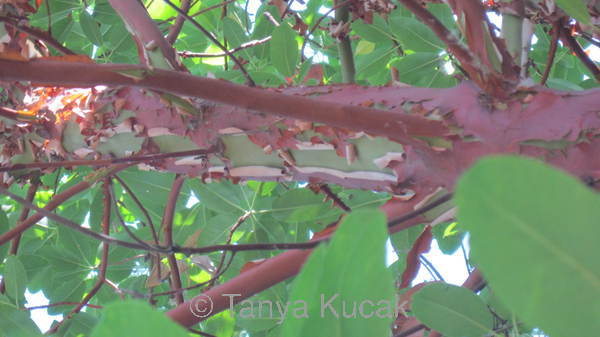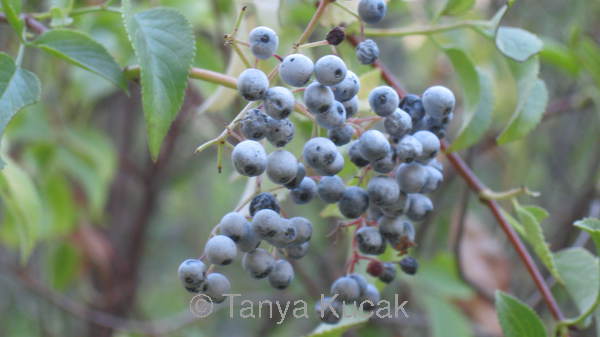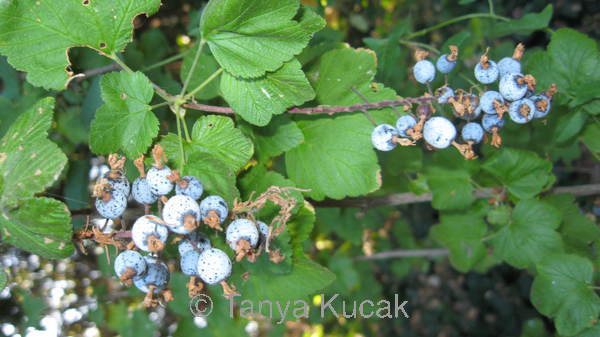
If you're eating blueberries or pomegranates for their chart-topping levels of antioxidants, you may be interested in a few native berries that nearly triple those values.
Alicia Funk sent samples to a lab and found out that elderberry, manzanita, and madrone fruits easily bested those more common fruits. She published the data in her book Living Wild: Gardening, Cooking and Healing with Native Plants of California (second edition, Flicker Press, 2013), co-authored with Karin Kaufman.
Funk discussed native foods and handed out samples at a recent local gathering. She encouraged people to grow these plants in their gardens rather than collecting them from somewhere else.
Note that it's illegal to collect plants from wildlands without a permit. In fact, get written permission before you collect plants from anywhere other than your own garden.
Native blue elderberries have a long history of use, but are best picked fully ripe and not eaten raw. The cooked or dried berries get sweeter, and compounds in the raw berries that might cause a reaction in sensitive people get detoxified. Elderberry syrup is an effective antiviral that has long been used for colds and flus, though most of the research has been done on European species.
Funk picks manzanita berries in the summer when they are ripe, a deep orange-red. Use whatever species is in abundance, she said. To separate the big seeds and the skins from the sugar, she grinds the berries in a blender or food processor on low for a couple minutes. Then she pours it all into a mesh strainer and pushes the sugar through with a wooden spoon. She sprinkles the strained product on cereal, adds it to baked goods as a gluten-free, antioxidant-rich flour, or uses it to flavor salad dressings. Either the whole berries or the manzanita sugar can be stored for a year, she said. Rather than discarding the seeds and skins, she simmers them in water for 20 minutes to make a refreshing drink.
If you're fortunate enough to have a mature Pacific madrone, the berries keep well refrigerated or dried. Funk made a Beyond Cranberry sauce using madrone berries for Thanksgiving. She also recommends a delicious tea made from crumbled-off madrone bark. Pour hot water over some bark shreds, steep for 10 minutes, and strain.
You can make a caffeine-free wake-up tea that has the same catechins as green tea, Funk said. She sent samples of her local deer brush, C. integerrimus, to a lab. Add a few fresh or dried ceanothus leaves to a cup, pour hot water over them, and steep no more than 2 or 3 minutes. Like green tea, Funk said, it gets bitter if it steeps too long.
Finally, toyon berries are available in the winter when not much else is, Funk said. The berries don't taste good fresh, but get sweeter when they're dried. She grinds the dried berries into a powder and uses it as a condiment on her cereal or in vegetable stir-fries. It adds tanginess and is a good source of antioxidants.

Use the peeling shreds of madrone bark to make a tasty tea. Or, if you can reach the berries, use them to make a Beyond Cranberry sauce. add them to stir-fries with rice and vegetables, or eat them as is.

Blue elderberries have a long history of traditional use for colds and flus, supported by recent research. To eat the berries, cook or dry them first.

Collect manzanita berries in the summer when they are fully ripe. Gently grind and sift them to separate the large seeds and the skins, and use the remaining “manzanita sugar” as a condiment or in recipes. Steep the leftover seeds and skins to make a refreshing summer drink.

Many currants are tasty raw. These Ribes sanguineum berries look a bit overripe. To collect thorny gooseberries, put a basket under the bush as you tap it gently with a stick. Catch the ripe berries in the basket.
© 2013 Tanya Kucak